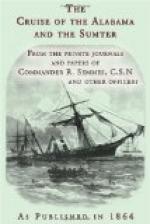The afternoon of the next day brought the Sumter to the coast of (Dutch) Guiana; but there being no pilot to be found, she was compelled to come to an anchor in about four fathoms of water. Here, as the sun set, the dark smoke of a steamer was discovered against the glowing sky, and suspicion was at once aroused that the new comer must be a Yankee cruiser on the look-out for the Confederate “pirates.” The drums beat to quarters on board of the little Sumter; decks were cleared for action; ports were triced up, guns run out, and every preparation made to give the supposed enemy a warm reception. Darkness had closed in as the suspected vessel approached; the thump, thump, thump of her screw sounding plainly on the still night air. Silently she approached the watchful cruiser, steering completely round her anchorage, as though herself suspicious of the character of her new companion. No hostile demonstration, however, followed; the night was too dark to distinguish friend from foe; and the strange sail having come to anchor at some little distance from the Sumter, and evincing no disposition to assume the offensive, the guns were run in again, and the men were at length dismissed to the hammocks.
Early next morning steam was again got up on board the Confederate cruiser, which ran down under French colours for a closer examination of the stranger, who was lying quietly at anchor about two miles in-shore of her. As the Sumter approached she also mounted the tricolor, at the sight of which the pretended nationality of the cruiser was laid aside, and the stars and bars flew out gaily from her mizen-peak. The Frenchman appeared much pleased at having thus fallen in with the celebrated Sumter; and being, like her, bound into Paramaribo, and of considerably lighter draught, invited her to follow him into the river, where a pilot might be obtained.
Arrived in Paramaribo the Sumter received tidings of the United States steamer Keystone State, which had been “in pursuit” of her for some time. This vessel was not very much larger than the Sumter, and their crews and armaments were very nearly equal, so there were great hopes on board the Confederate of a brush with the enemy on something like equal terms. These hopes, however, like so many others, were doomed to disappointment. By some fatality the Keystone State could never manage to come up with her quarry. While the latter had been coaling at Trinidad, she was performing a similar operation at Barbados, arriving thence at Trinidad after the Sumter had sailed. From this port she again started “in pursuit,” but her chances of overtaking her enemy may perhaps have been somewhat affected by the fact, that on learning that the Sumter had started eastward, she at once followed upon a westerly track, which, doubtless to the great grief of her commander and crew, somehow failed to bring her alongside of the vessel of which she was in search.[2]




